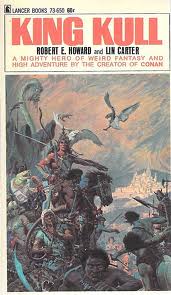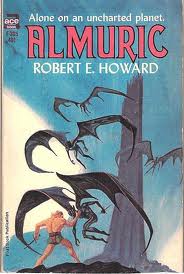With a new Conan movie supposedly on the horizon—although I think it’s been stuck in “development hell” for a while—I’d like to revisit this post about the barbarian’s creator, Robert E. Howard.

Robert E. Howard
Readers of sword & sorcery, sword & planet, science fiction, fantasy, and horror undoubtedly know the name of Robert E. Howard. For the majority of people, not so much. But just about everyone is familiar with the name of Howard’s most famous creation: Conan the Barbarian. More than likely this familiarity stems from Conan’s two big-screen romps (hokey, but fun) in the 1980s, with the former Governator of my esteemed home state in the lead role. (Hardly any dialogue; at the time, a perfect role for him.) Or perhaps the 2011 CGI-fest (super hokey, and not nearly as much fun), with a younger, hunkier actor playing the brooding Cimmerian.
More important is the man behind Conan. I got to thinking about Howard while preparing to reissue one of my sword & sorcery novels from the 1980s, The Sons of Ornon (originally published as The Twentieth Son of Ornon by Zebra Books). How could I not think about a writer that, in many quarters, is considered the originator of the sub-genre known as sword & sorcery?
 Robert Ervin Howard was born in 1906 in Peaster, Texas but spent the majority of his life, right up until his death, in the central Texas town of Cross Plains. As a teenager Howard became addicted to pulp fiction. (No, not the movie.) These were magazines known collectively as “the pulps” because of the inexpensive wood pulp paper on which they were printed. These pulps, which began in the late nineteenth century and were published into the 1950s, featured all genres of fantastic tales, many written by authors of renown such as H. Rider Haggard, Talbot Mundy, and my personal muse, Edgar Rice Burroughs. Argosy was the first pulp, but later ones bore the obvious titles of Horror Stories, Planet Stories, and Weird Tales, among numerous others. A voracious reader, Howard began writing and submitting stories to the pulps. In short order this self-taught writer had amassed an imposing stack of rejection slips. (To those of you out there who write: sound familiar?)
Robert Ervin Howard was born in 1906 in Peaster, Texas but spent the majority of his life, right up until his death, in the central Texas town of Cross Plains. As a teenager Howard became addicted to pulp fiction. (No, not the movie.) These were magazines known collectively as “the pulps” because of the inexpensive wood pulp paper on which they were printed. These pulps, which began in the late nineteenth century and were published into the 1950s, featured all genres of fantastic tales, many written by authors of renown such as H. Rider Haggard, Talbot Mundy, and my personal muse, Edgar Rice Burroughs. Argosy was the first pulp, but later ones bore the obvious titles of Horror Stories, Planet Stories, and Weird Tales, among numerous others. A voracious reader, Howard began writing and submitting stories to the pulps. In short order this self-taught writer had amassed an imposing stack of rejection slips. (To those of you out there who write: sound familiar?)
Howard sold his first story to Weird Tales in 1924 for the staggering sum of $16. Well, at least he’d gotten published. He continued to work at all sorts of jobs—even a stint as a soda jerk—as subsequent stories were published, and for a short while he even stopped writing, given his frustration over the minimal compensation. Then, at the age of twenty-one, he rewrote an unpublished story about a barbarian named Kull and submitted it to Weird Tales. The story, titled “The Shadow Kingdom,” was new and different, a blend of mythology, fantasy, and horror, seasoned with sword fighting and a pinch of romance. Hey, that sounds like sword & sorcery to me! Ultimately, a whole lot of people would think the same thing. The magazine paid him $100 for the story.
 But after Kull, and another sword & sorcery character named Solomon Kane, Howard turned to boxing stories, which proved lucrative for a number of years. Barely in his mid-twenties, Howard now made his living as a full-time writer. In addition to boxing stories he wrote tales based on Celtic lore, and his fascination with history led to bloody war stories from the Middle Ages and other periods. He became a devotee of the works of H.P. Lovecraft, and he even began a correspondence with this master of horror. That influence was evident in a number of his stories in the early 1930s.
But after Kull, and another sword & sorcery character named Solomon Kane, Howard turned to boxing stories, which proved lucrative for a number of years. Barely in his mid-twenties, Howard now made his living as a full-time writer. In addition to boxing stories he wrote tales based on Celtic lore, and his fascination with history led to bloody war stories from the Middle Ages and other periods. He became a devotee of the works of H.P. Lovecraft, and he even began a correspondence with this master of horror. That influence was evident in a number of his stories in the early 1930s.
Conan was also “born” in the early ’30s. Set in the mythical Hyborian Age, these stories became wildly popular after Weird Tales published the first one late in 1932—though not before earlier stories brought a few more rejections. Through 1936, the magazine published seventeen Conan tales. It also published, in installments, the only full-length Conan novel, The Hour of the Dragon, which would later be published by Lancer Books as Conan the Conqueror. With the Conan stories, the foundation for the sword & sorcery genre had been established.
My own Conan collection grew in the 1960s when the now-defunct Lancer Books published what it called “The Complete Conan.” Most had a price of 60¢ and cover art by the greatest of all, Frank Frazetta. Gee, I wonder what the collection is worth… I even own an Ace edition of Howard’s sole sword & planet novel, Almuric. Needless to say, I treasure them all.
 Howard’s personal life, and ultimate death, could be a book unto itself. He never married, and it is believed that he only had one relationship late in his life, with a woman named Novalyne Price. Years later, Price wrote a book about their relationship, one that was made into a 1996 movie titled The Whole Wide World, starring Renée Zellweger. (Check out next Thursday’s post.)
Howard’s personal life, and ultimate death, could be a book unto itself. He never married, and it is believed that he only had one relationship late in his life, with a woman named Novalyne Price. Years later, Price wrote a book about their relationship, one that was made into a 1996 movie titled The Whole Wide World, starring Renée Zellweger. (Check out next Thursday’s post.)
Howard was fiercely devoted to his mother, Hester Howard. In the summer of 1936, gravely ill, she slipped into a coma. A nurse told Howard that she would not regain consciousness. Howard walked out of the house, climbed into the family car, and fired a bullet into his head. He died a few hours later at the age of thirty. Hester died the next day, and they were buried simultaneously.
A writer’s what if: What if Robert E. Howard had lived a normal lifespan? How much more wonderful work would he have created? Sad…
